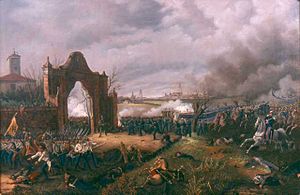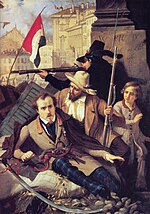First Italian War of Independence: Difference between revisions
cite |
→The war: copy ex "Battle of Custoza (1848) " |
||
| Line 47: | Line 47: | ||
The French did not enter the First War for Italian Independence in 1848. When the Piedmontese Army under [[Charles Albert of Sardinia|Carl Albert]] King of Sardinia marched into Austrian held Italy with the intent of linking up with the revolutionaries of Venice, the Piedmontese met the large Austrian Army under Field Marshal [[Joseph Radetzky von Radetz|Josef Radetzky]]. At the [[Battle of Goito|Curtatone]] on May 29, 1848, the Austrians attacked a combined force of Piedmontese and Tuscan troops. Although the Austrians won the battle, the resistance offered at Curtatone allowed the Piedmontese troops to regroup and win the [[Battle of Goito]] the next day—May 30, 1848. |
The French did not enter the First War for Italian Independence in 1848. When the Piedmontese Army under [[Charles Albert of Sardinia|Carl Albert]] King of Sardinia marched into Austrian held Italy with the intent of linking up with the revolutionaries of Venice, the Piedmontese met the large Austrian Army under Field Marshal [[Joseph Radetzky von Radetz|Josef Radetzky]]. At the [[Battle of Goito|Curtatone]] on May 29, 1848, the Austrians attacked a combined force of Piedmontese and Tuscan troops. Although the Austrians won the battle, the resistance offered at Curtatone allowed the Piedmontese troops to regroup and win the [[Battle of Goito]] the next day—May 30, 1848. |
||
The Piedmontese Army was defeated by Radetzky and the Austrians at [[Battle of Custoza (1848)|Custoza]] on July 25, 1848.<ref>Denis Mack Smith, ''Modern Italy: A Political History'' (University of Michigan Press: Ann Arbor, 1997) p. 19.</ref> The defeat of the Piedmontese at Custoza was followed up by the capture of [[Milan]] on August 6, 1848 |
The Piedmontese Army was defeated by Radetzky and the Austrians at [[Battle of Custoza (1848)|Custoza]] on July 25, 1848.<ref>Denis Mack Smith, ''Modern Italy: A Political History'' (University of Michigan Press: Ann Arbor, 1997) p. 19.</ref> The defeat of the Piedmontese at Custoza was followed up by the capture of [[Milan]] on August 6, 1848. While not a total Austrian victory, the spirit of King Charles Albert and of his generals was all but broken. |
||
An armistice was signed on August 9, 1848 between Austria and Sardinia at [[Vigevano]]. The Piedmontese Army retreated within the borders of the Kingdom of Sardinia. This armistice, however, lasted less than seven months, before Charles Albert denounced the truce on March 12, 1849. The Austrian army took the military initiative in [[Lombardy]] and heavily defeated the Piedmontese at [[Battle of Novara (1849)|Novara]] on March 23, 1849. After this victory the Piedmontese were driven back to Borgomanero at the foot of the Alps, and the Austrian forces occupied [[Battle of Novara (1849)|Novara]], [[Vercelli]], [[Trino]] and [[Brescia]], with the road to the Piedmontese capital, [[Turin]], lying open to them. The attempt to renew the war was a disaster. It resulted in another victory for Radetzky and the effective end of the First Italian War of Independence; all the rebellious provinces returned to Austrian rule. |
|||
| ⚫ | Charles Albert abdicated in favor of his son [[Victor Emmanuel II of Italy|Victor Emmanuel]], and a peace treaty was signed on August 6, 1849 and Piedmont-Sardinia was forced to pay an indemnity of 65 million francs to Austria.<ref>{{cite book|author=M. Clark|title=The Italian Risorgimento|url=https://books.google.com/books?id=lW3aAAAAQBAJ&pg=PA55|year=2013|publisher=Routledge|page=55}}</ref> |
||
| ⚫ | Charles Albert abdicated in favor of his son [[Victor Emmanuel II of Italy|Victor Emmanuel]], and a peace treaty was signed on August 6, 1849 and Piedmont-Sardinia was forced to pay an indemnity of 65 million francs to Austria.<ref>{{cite book|author=M. Clark|title=The Italian Risorgimento|url=https://books.google.com/books?id=lW3aAAAAQBAJ&pg=PA55|year=2013|publisher=Routledge|page=55}}</ref> |
||
==See also== |
==See also== |
||
Revision as of 12:04, 12 November 2016
| First Italian War of Independence | |||||||||
|---|---|---|---|---|---|---|---|---|---|
| Part of the Wars of Italian Unification | |||||||||
 The Battle of Novara (1849) | |||||||||
| |||||||||
| Belligerents | |||||||||
|
Supported by: |
| ||||||||
| Commanders and leaders | |||||||||
|
|
| ||||||||
| Strength | |||||||||
|
|
| ||||||||
The First Italian War of Independence was fought in 1848 and 1849 between the losers, the Kingdom of Sardinia (Piedmont) and the winners, Austrian Empire. The war saw main battles at Custoza and Novara in which the Austrians under Radetzky managed to defeat the Piedmontese.
The war was part of the Revolutions of 1848 in the Italian states, which generally saw the reactionary forces triumphant and many rebels forced into exile.[1][2]
The revolution of 1848
In 1848 revolutionary riots broke out in in many parts of Europe, including numerous places in the Apennines and other parts of Italy. Charles Albert of Piedmont (Sardinia) and Leopold II of Tuscany were forced to make concessions to the democrats. Charles II, Duke of Parma was ousted. Sicily, excepting Messina, revolted against the Bourbon Kingdom of the Two Sicilies.
There were also rebellions in the two capitals of the Austrian-controlled Kingdom of Lombardy-Venetia, Milan (the Five Days of Milan) and Venice (the Repubblica di San Marco). With Vienna itself in revolt, the Austrian Empire was tottering.
The Kingdom of Sardinia decided to exploit the apparently favorable moment. Sardinia declared war on Austria, in alliance with the Papal States and the Two Sicilies, and invaded Austria's Italian possessions.[3]
The war
The Piedmontese army was composed of two corps and a reserve division, for a total of 12,000 troops. Artillery and cavalry were the best units. On March 21 the Grand Duke of Tuscany also declared his entrance in the war against Austria, with a contingent of 6,700 men. The Papal Army had a similar sized force, backed by numerous volunteers. On March 25 the vanguard of the II Piedmontese Corps entered Milan and two days later also Pavia was freed.
After an initial successful campaign, with the victories at Goito and Peschiera del Garda, Pope Pius IX recalled his troops due to fear of possible expansions of Piedmont in case of victory. The kingdom of the Two Sicilies also retired, but the general Guglielmo Pepe refused to return to Naples and instead went to Venice to protect it against the Austrian counter-offensive. King Ferdinand II's retreat was mainly due to the ambiguous behaviour of Charles Albert of Piedmont, who had not clearly refused the proposal to obtain the Sicilian crown received from representatives of the rebellious island.
In the revolutionary year of 1848, popular uprisings were springing up everywhere in Europe. Revolutionaries in many countries supported a revolution to establish constitutions and representative government in much of Europe (except for Britain and Russia). In every case the reactionary forced prevailed using military force.[4]



The French did not enter the First War for Italian Independence in 1848. When the Piedmontese Army under Carl Albert King of Sardinia marched into Austrian held Italy with the intent of linking up with the revolutionaries of Venice, the Piedmontese met the large Austrian Army under Field Marshal Josef Radetzky. At the Curtatone on May 29, 1848, the Austrians attacked a combined force of Piedmontese and Tuscan troops. Although the Austrians won the battle, the resistance offered at Curtatone allowed the Piedmontese troops to regroup and win the Battle of Goito the next day—May 30, 1848.
The Piedmontese Army was defeated by Radetzky and the Austrians at Custoza on July 25, 1848.[5] The defeat of the Piedmontese at Custoza was followed up by the capture of Milan on August 6, 1848. While not a total Austrian victory, the spirit of King Charles Albert and of his generals was all but broken.
An armistice was signed on August 9, 1848 between Austria and Sardinia at Vigevano. The Piedmontese Army retreated within the borders of the Kingdom of Sardinia. This armistice, however, lasted less than seven months, before Charles Albert denounced the truce on March 12, 1849. The Austrian army took the military initiative in Lombardy and heavily defeated the Piedmontese at Novara on March 23, 1849. After this victory the Piedmontese were driven back to Borgomanero at the foot of the Alps, and the Austrian forces occupied Novara, Vercelli, Trino and Brescia, with the road to the Piedmontese capital, Turin, lying open to them. The attempt to renew the war was a disaster. It resulted in another victory for Radetzky and the effective end of the First Italian War of Independence; all the rebellious provinces returned to Austrian rule.
Charles Albert abdicated in favor of his son Victor Emmanuel, and a peace treaty was signed on August 6, 1849 and Piedmont-Sardinia was forced to pay an indemnity of 65 million francs to Austria.[6]
See also
- Revolutions of 1848 in the Italian states
- Italian unification
- Second Italian War of Independence
- Third Italian War of Independence
References
- ^ William K. Langer, Political and Social Upheaval, 1832-1852 (1969) pp 371-86.
- ^ Priscilla Robertson, Revolutions of 1848: a social history (1952). pp 309-401.
- ^ Avery, Robert. The First Italian War of Independence (1848-49) - A Military History The Victorian Web.
- ^ William K. Langer, Political and Social Upheaval, 1832-1852 (1969) pp 312-512.
- ^ Denis Mack Smith, Modern Italy: A Political History (University of Michigan Press: Ann Arbor, 1997) p. 19.
- ^ M. Clark (2013). The Italian Risorgimento. Routledge. p. 55.
Further reading
- Berkeley, G. F.-H. Italy in the Making January 1st 1848 to November 16th 1848 (3 vol. 1940), highly detailed scholarly narrative; 542pp excerpt vol 3
- Coppa, Frank J. The origins of the Italian wars of independence (1992).
- Langer, William K. Political and Social Upheaval, 1832-1852 (1969) pp 371-86.
- Robertson, Priscilla. Revolutions of 1848: a social history (1952). pp 309-401.
- Smith, Denis Mack, Modern Italy: A Political History (University of Michigan Press: Ann Arbor, 1997).
- Trevelyan, George Macaulay. Garibaldi's Defence of the Roman Republic (1907) online free
- "Charles Albert" 1911 Encyclopædia Britannica

